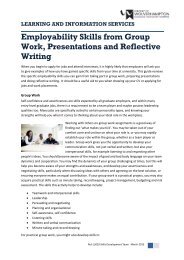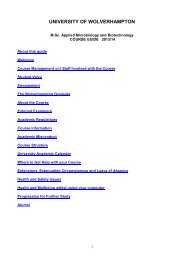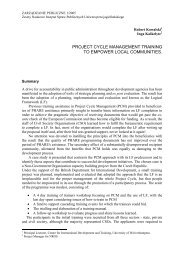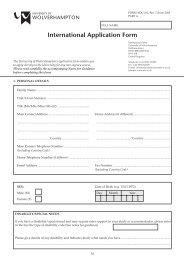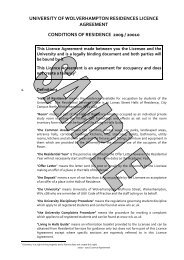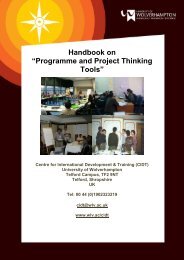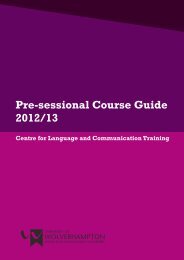In Support of Evidence-Based Healthcare Management: an ...
In Support of Evidence-Based Healthcare Management: an ...
In Support of Evidence-Based Healthcare Management: an ...
- No tags were found...
Create successful ePaper yourself
Turn your PDF publications into a flip-book with our unique Google optimized e-Paper software.
<strong>In</strong> <strong>Support</strong> <strong>of</strong> <strong>Evidence</strong>-<strong>Based</strong> <strong>Healthcare</strong> <strong>M<strong>an</strong>agement</strong>_________________________________________________________________________________________researchers who have used approaches relying on the ‘absolute or relative frequency <strong>of</strong> observedbehaviours’ rather th<strong>an</strong> the ‘quality <strong>of</strong> specific behaviours’.The results <strong>of</strong> the NHS research reported in this article support to some degree the findings <strong>of</strong>Americ<strong>an</strong> researchers such as Shipper, (1991 & 2000), Atwater <strong>an</strong>d Yammarino (1992), Tsui <strong>an</strong>dAshford (1994) <strong>an</strong>d, <strong>of</strong> Europe<strong>an</strong> researchers such as V<strong>an</strong> Der Velde et al (1999), who argue that thejudgements <strong>an</strong>d perceptions <strong>of</strong> behaviour constituting m<strong>an</strong>agerial effectiveness <strong>of</strong> superiors <strong>an</strong>dsubordinates <strong>of</strong>ten differ from the self-perception <strong>an</strong>d judgement <strong>of</strong> m<strong>an</strong>agers themselves. Howeverthe differences in judgement that have emerged from the study are very limited in number across thefull r<strong>an</strong>ge <strong>of</strong> m<strong>an</strong>ager <strong>an</strong>d non m<strong>an</strong>ager perspectives. The vast majority <strong>of</strong> the criteria appear to beheld in common, not only within the two respective org<strong>an</strong>isations, but also between them. This pointsto a signific<strong>an</strong>t amount <strong>of</strong> generalisability <strong>of</strong> the identified criteria <strong>of</strong> m<strong>an</strong>agerial effectiveness.Over the past two decades there has been considerable debate <strong>an</strong>d controversy within the UKconcerning the notion <strong>of</strong> the ‘universally effective m<strong>an</strong>ager’. Some believe that “a set <strong>of</strong> universallyapplicable m<strong>an</strong>agement competence criteria - independent <strong>of</strong> function <strong>an</strong>d org<strong>an</strong>isational context” c<strong>an</strong>be derived as epitomised by the work <strong>of</strong> Boyatzis (Training Agency, 1988). Other expertcommentators such as John Burgoyne, have argued that this approach is misconceived <strong>an</strong>d “auniversal mech<strong>an</strong>ism is inappropriate” (Bennett & L<strong>an</strong>gford, 1983; Herriot, 1988; Smith et al 1989;Jacobs, 1989; Willcock, 1992; Hamlin & Stewart, 1998). <strong>In</strong> a similar vein Fl<strong>an</strong>ag<strong>an</strong> (1990) <strong>an</strong>dFl<strong>an</strong>ag<strong>an</strong> & Spurgeon (1996) assumed for their research into m<strong>an</strong>agerial effectiveness in the NHS thatm<strong>an</strong>agerial effectiveness is a subjective vision determined by factors within each org<strong>an</strong>isation, <strong>an</strong>dthat m<strong>an</strong>agerial competencies are situationally dependent, contingent upon the org<strong>an</strong>isational context<strong>an</strong>d therefore ‘org<strong>an</strong>isation-specific’. They argue that “for <strong>an</strong>y one org<strong>an</strong>isation there is merit inreinventing the wheel in terms <strong>of</strong> identifying the particular skills <strong>an</strong>d behaviours that are perceived bym<strong>an</strong>agers to represent effective m<strong>an</strong>agement in that org<strong>an</strong>isation at that time”, <strong>an</strong>d that “borrowingsets <strong>of</strong> words or competencies from <strong>an</strong>other org<strong>an</strong>isation, even a common set derived from a r<strong>an</strong>ge <strong>of</strong>org<strong>an</strong>isations, is only useful if they are debated in terms <strong>of</strong> me<strong>an</strong>ing <strong>an</strong>d value to the org<strong>an</strong>isation inquestion, <strong>an</strong>d then internalised <strong>an</strong>d operationalised by its m<strong>an</strong>agers”.However, the high degree <strong>of</strong> similarity, coincidence <strong>an</strong>d potential generalisability revealed by thepresent study challenge these ‘contingent’ <strong>an</strong>d ‘org<strong>an</strong>isation-specific’ models <strong>of</strong> m<strong>an</strong>agerialeffectiveness, <strong>an</strong>d point towards the existence <strong>of</strong> the ‘universally effective m<strong>an</strong>ager’ as reported byBennett & L<strong>an</strong>gford (1983) <strong>an</strong>d previously evidenced by Hamlin (1988). Although at the‘behavioural level’ m<strong>an</strong>y <strong>of</strong> the critical incidents <strong>an</strong>d behavioural items identified by the research areclearly specifically related in their detail to the org<strong>an</strong>isational setting <strong>of</strong> the NHS <strong>an</strong>d HM Customs &Excise respectively, <strong>an</strong>d at the ‘factorial level’ a number <strong>of</strong> the identified criteria <strong>of</strong> m<strong>an</strong>agerialeffectiveness are ‘org<strong>an</strong>isation-specific’ <strong>an</strong>d/or ‘perspective-specific’, the large majority <strong>of</strong> behaviours<strong>an</strong>d factors (criteria) are held in common across all perspectives <strong>an</strong>d between org<strong>an</strong>isations. Thissuggests these criteria possess ‘universal’ characteristics. Whilst at a behavioural level the researchlends a degree <strong>of</strong> support to the ‘contingent model <strong>of</strong> m<strong>an</strong>agerial effectiveness’ adopted by Fl<strong>an</strong>ag<strong>an</strong><strong>an</strong>d Spurgeon (1996), at the factorial level the results overall support more strongly the notion <strong>of</strong> the‘universally effective m<strong>an</strong>ager’. This challenges Fl<strong>an</strong>ag<strong>an</strong> <strong>an</strong>d Spurgeon’s view that there c<strong>an</strong> be ‘nosingle clear picture <strong>of</strong> effective m<strong>an</strong>agement or effective m<strong>an</strong>agers.’Limitation <strong>of</strong> the StudyOne limitation <strong>of</strong> the study is that it was undertaken in a single NHS Trust hospital. Therefore thecriteria <strong>of</strong> m<strong>an</strong>agerial effectiveness identified c<strong>an</strong>not yet be regarded categorically as generalised to<strong>an</strong>y population <strong>of</strong> healthcare m<strong>an</strong>agers beyond those in the study. Similar research needs to be carriedout in other types <strong>of</strong> NHS Trust healthcare settings including both acute <strong>an</strong>d community hospitals.However, the high degree <strong>of</strong> similarity <strong>an</strong>d coincidence revealed between the two studies suggestsm<strong>an</strong>y <strong>of</strong> the positive <strong>an</strong>d negative criteria identified are likely to be generalisable <strong>an</strong>d ‘universal’. Asecond limitation is the comparative lack <strong>of</strong> equivalent or near equivalent empirical case studyresearch in other org<strong>an</strong>isations <strong>an</strong>d other sectors against which to compare the findings.19 <strong>M<strong>an</strong>agement</strong> Research Centre 2001



